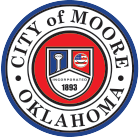Fire Prevention & Safety
Education & Safety
The Moore Fire Department offers education on a variety of safety and preparedness topics in conjunction with the Moore Emergency Management Department. We believe it is paramount to approach safety through a proactive approach to reduce the number of emergencies in our great city.
Check out the files provided to help create a family fire escape plan and to make sure you are taking all preventative measures to reduce the risk of a fire in your home.
Install. Inspect. Protect.
More than 3,000 people die in home fires each year in the United States; most of whom are in homes without a working smoke alarm. To prevent these deaths, the U.S. Fire Administration (USFA), a division of the Federal Emergency Management Agency (FEMA) is sponsoring a nationwide Install. Inspect. Protect. Campaign designed to raise awareness about how working, properly installed smoke alarms can lower a person’s chances of dying in a fire. Moore Fire Department is supporting this critical effort to reduce injuries and the loss of life.
If you need help installing a smoke alarm please contact us at 405-793-5110 and we can send out a crew to help you.
Carbon Monoxide Facts
Carbon monoxide (CO) is a gas that you cannot see, taste or smell. In 2009, poison control centers reported more than 3,551 cases of carbon monoxide exposure in children 19 and under.
Fuel-powered devices can provide wonderful benefits to families when used properly. But they also underscore an important necessity in the home: the need for a carbon monoxide alarm. Carbon monoxide poisoning can result from faulty furnaces or other heating appliances, portable generators, water heaters, clothes dryers, or cars left running in garages. At its worst, carbon monoxide can cause severe side effects or even death. Young children are especially vulnerable to the effects of carbon monoxide because of their smaller bodies. Children process carbon monoxide differently than adults, may be more severely affected by it, and may show signs of poisoning sooner. Symptoms of carbon monoxide poisoning include headache, nausea and drowsiness.

